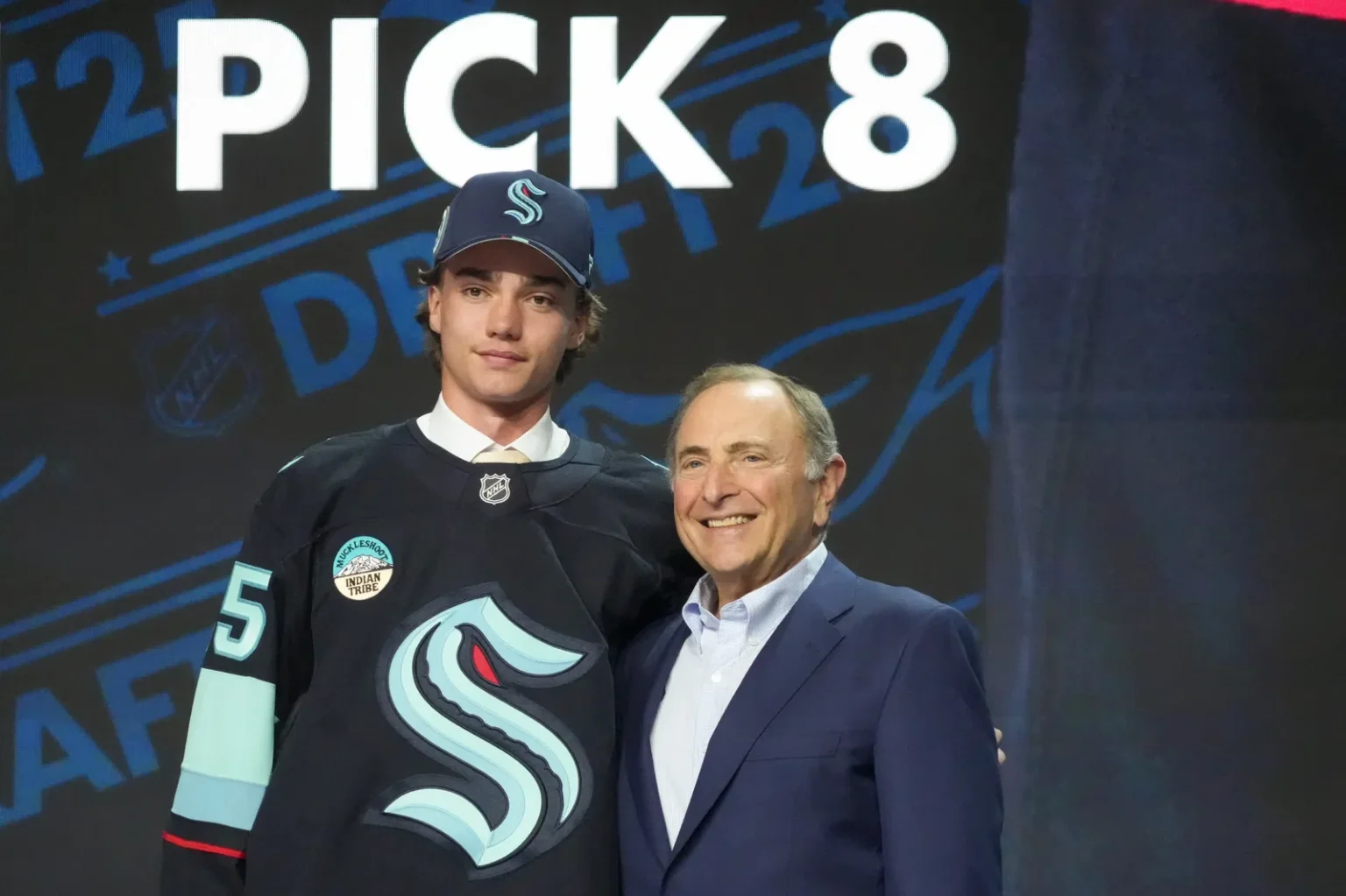The Seattle Kraken are here in the NHL prospect pool overview series.
Tony Ferrari digs into the Kraken’s strengths and weaknesses, latest draft class, positional depth chart, next player in line for an NHL opportunity and more. A player who no longer holds rookie eligibility in the NHL is considered graduated and no longer a prospect for these exercises, with few exceptions.
Initial Thoughts
The Seattle Kraken are a young franchise, but they’ve quickly built up a very solid prospect pool, with a focus on center depth and players who play a strong transition game. Some players don’t fit that bill perfectly, but they seem to have a type.
Berkly Catton is among the more interesting players in the pipeline, looking like a player that could be a potential game breaker with his speed and evasiveness combined with his elite playmaking touch. Catton has surpassed the 100-point mark in each of the last two seasons, scoring at a 1.8 point per game clip over that time. He is in the awkward position of being just too young for the AHL, being a January 2006 birthday, while also having proven everything he could have at the WHL level. The NHL is an option, but that would be a big jump. It wouldn’t be surprising to see him stick out of training camp and eventually be sent back to junior before the World Junior Championship, where he could lead Team Canada.
Leaping into pro hockey this season will be Carson Rehkopf, a winger who plays a tactical game and gets into shooting positions with ease. Whether he is attacking off the rush or hunting down pockets of space away from the puck, Rehkopf might be the most natural finisher in the Seattle pipeline. He’s grown into much more than a triggerman over the last couple of years though, developing a passing game that utilizes delays and quick cuts to change angles and open lanes. Rehkopf could be a player who makes an instant impact in the AHL and finds himself in NHL games by season’s end.
The development of Clarke Caswell over the last few years has been interesting. He’s a strong transition forward who can weave his way up ice with speed, generating lateral quickness from crossovers. He also possesses some of the most impressive play connecting ability in the pipeline, consistently looking to make quick decisions or smart little bumper passes. He can make plays from all over the zone, going low-to-high or finding a late man in the zone for a scoring chance. Caswell is a very smart player all over the ice, and there could be a steady and tactical middle-six forward in the NHL one day.
Jagger Firkus is a jitterbug who is an electric offensive presence with an absolute whippy shot and some incredibly creative passing. Firkus is a crafty player, and there were some growing pains in his first AHL season, but he could be in line for a breakout season. His puck handling makes him slippery, cutting laterally or shifting his weight to give himself a small shooting window or passing lane. There aren’t many more entertaining players to watch in the AHL.
After three steady years of improvement at the SHL level, Danish forward Oscar Fisker Molgaard joined the AHL’s Coachella Valley Firebirds to end last season and looked like he fit right in. Fisker Molgaard is a player who focuses on the details, ensuring he’s doing the little things and finding success because of it. He’s a very fluid skater who gets around the ice with ease, using his mobility to impact the game defensively, aided by excellent reads on the backcheck. He should be a player who finds plenty of success as a third-line center one day, using the intelligence and poise that he plays with to pick apart opponents tactically.
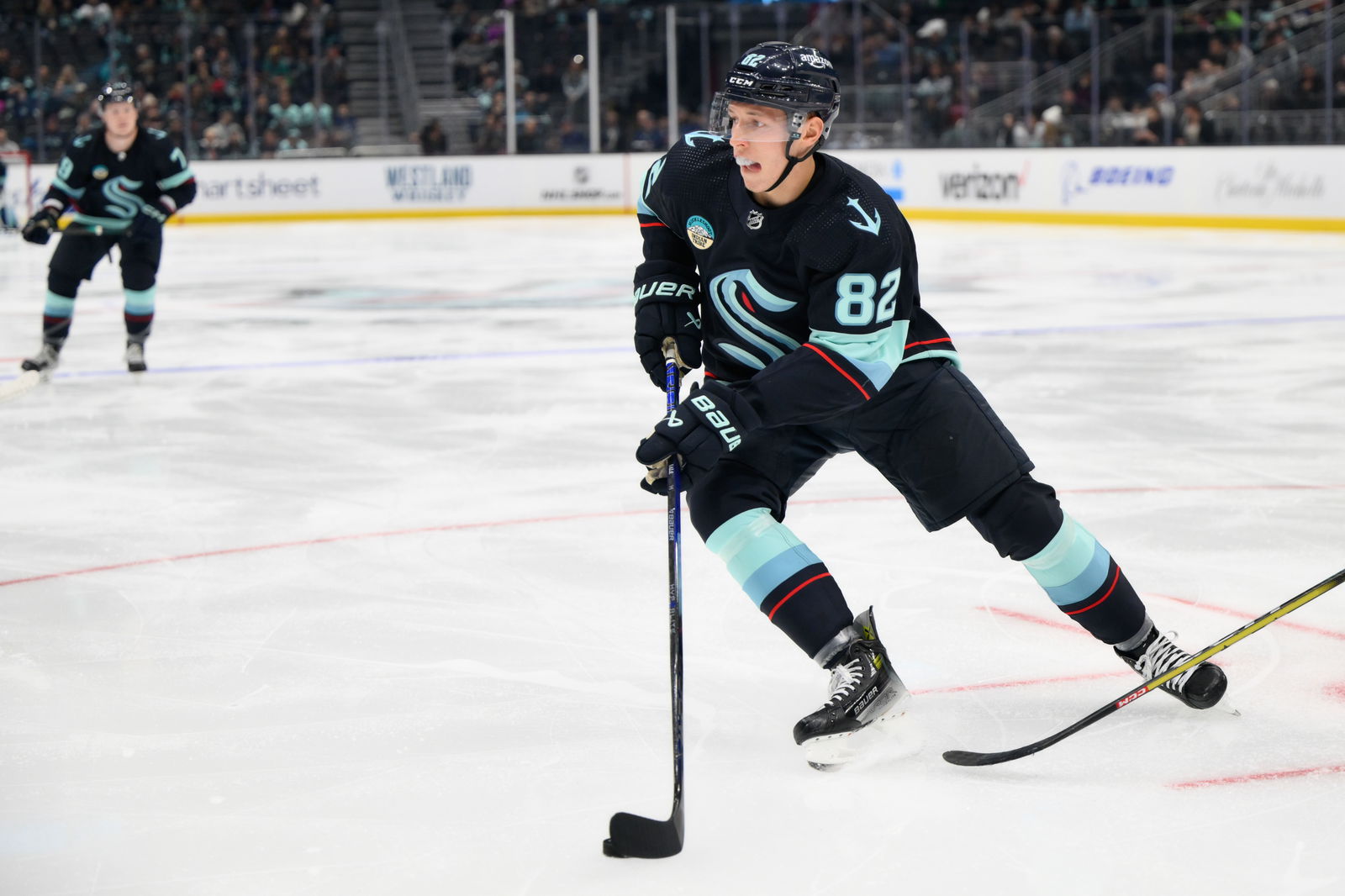
Former OHLers David Goyette and Eduard Sale had some ups and downs in their first full AHL season. Goyette is an elite passer who sees the ice as well as anyone. Sale is a player who skates into space and fires passes through traffic on the move. Both of them struggled to deal with the physicality a bit, with Goyette in particular taking some time to adjust. Both Sale and Goyette are immensely talented players, and they will need to take a step this season in the AHL.
It was a bit surprising to see Ty Nelson step into the AHL and have such an immediate impact. He’s always been a very engaged and driven player, but there was always concern about whether he would be able to continue that at the pro level, given his size. Nelson will throw his weight around, and he has a massive shot. In a lot of ways, Nelson plays a bit bigger than he actually is. When he’s engaged, he is a cerebral player. He will have to continue finding ways to prove his size isn’t an issue, but he’s built like a truck and loves to get involved in all aspects of the game.
Last year was a bit tough for Caden Price. In his final junior season, he was traded, which isn’t an uncommon occurrence, but he really struggled to find his footing after the trade. Price is a mobile defender who is at his best when he’s not trying to do too much at either end of the ice. He’s a capable defender who uses his feet and his frame to cut play off and turn it around, but sometimes he can get into chase mode and loses his positioning. Offensively, he’s a very crafty passer who can activate on the backside and become a shooting threat, but his reads aren’t always on point. Heading into his first AHL season, he will need to refine things on the decision-making front.
Lukas Dragicevic is a defender who loves attacking up ice, leading the rush and is developing a killer instinct. This past season, he elevated his offensive game even further, looking to push the pace when he had the puck on his stick. Dragicevic is a great straight-line mover, but he isn’t the most laterally capable skater, particularly at speed. That aspect usually shows up in his defensive coverage. He’s turning pro this fall, and it will be interesting to see what kind of role they give him out of the gate in the AHL. He has the offensive tools to be a rush-attacking blueliner and a potential power play quarterback, but his defensive game could limit his ice time if he doesn’t clean up his footwork a bit.
U-23 Players Likely To Be On NHL Roster This Season
Shane Wright (C), Matty Beniers (C)
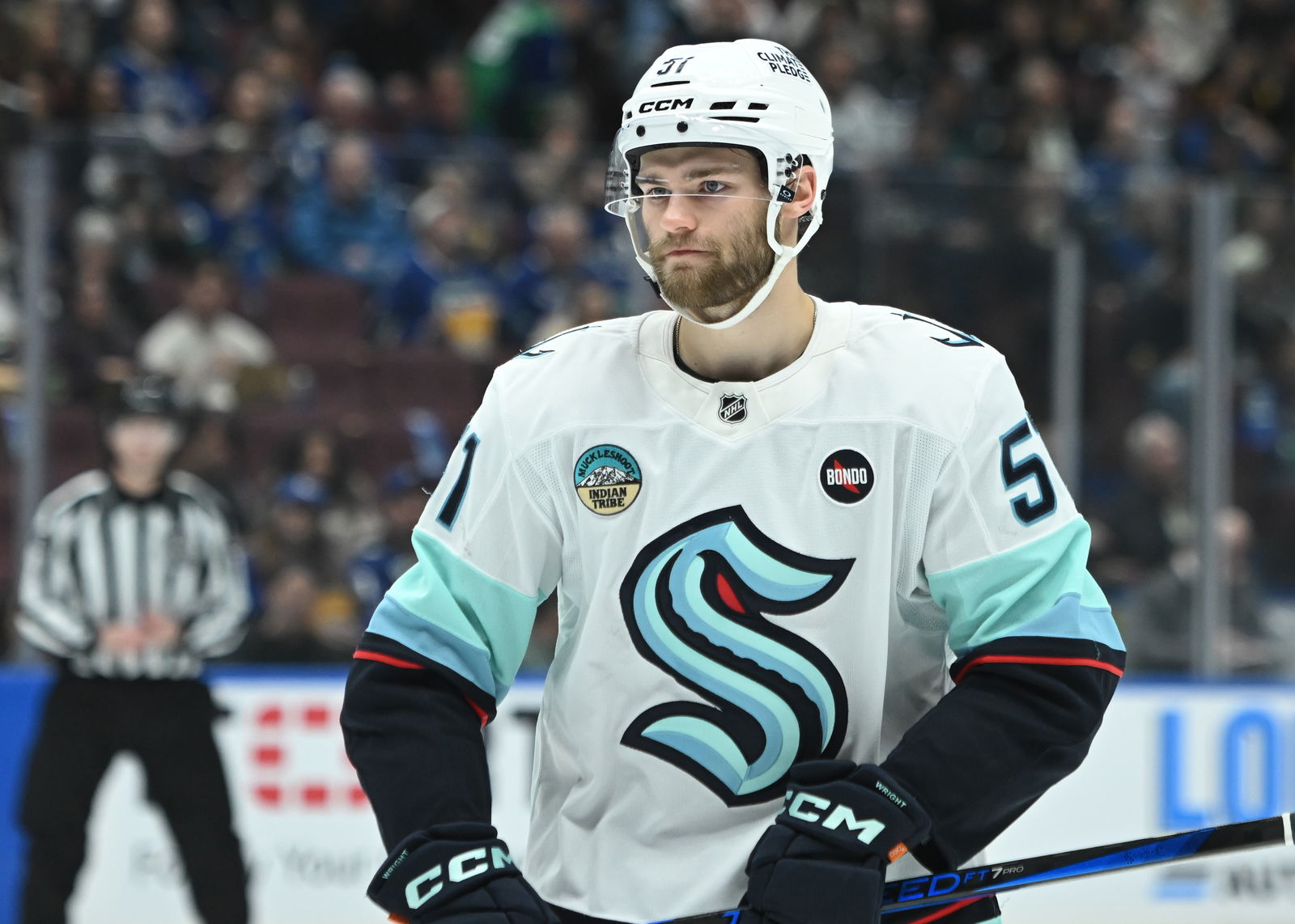
2025 NHL Draft Class
Round 1, 8th overall – Jake O'Brien, C, Brantford (OHL)
Round 2, 36th overall – Blake Fiddler, D, Edmonton (WHL)
Round 3, 68th overall – Will Reynolds, D, Acadie-Bathurst (QMJHL)
Round 5, 134th overall – Maxim Agafonov, D, Ufa Tolpar (Rus)
Round 7, 205th overall – Karl Annborn, D, HV71 Jr. (Swe)
Round 7, 218th overall – Loke Krantz, LW, Linkoping HC Jr. (Swe)
The Seattle Kraken love to draft centers, and they continued with that trend in the first round, taking Jake O’Brien out of the OHL. Part of the reason O’Brien was such an intriguing prospect who was constantly on the rise in the first half of the year was his physical gifts and the runway that he has in terms of filling out. He’s a tall, skinny kid who has already shown the elements of being a near-elite playmaker. If O’Brien can add some muscle over the next couple of years, he could very easily find himself to be a dominant blend of skill and power.
O’Brien is one of the premier playmakers in the 2025 draft class. His vision and play-reading ability with the puck on his stick is impressive, understanding where defenders are leaning and how they are trying to structure themselves to exploit where the lanes are. He is a good shooter as well, and adding some muscle will give him a bit more of a power option. O’Brien’s top ten selection is a bet on skill and potential.
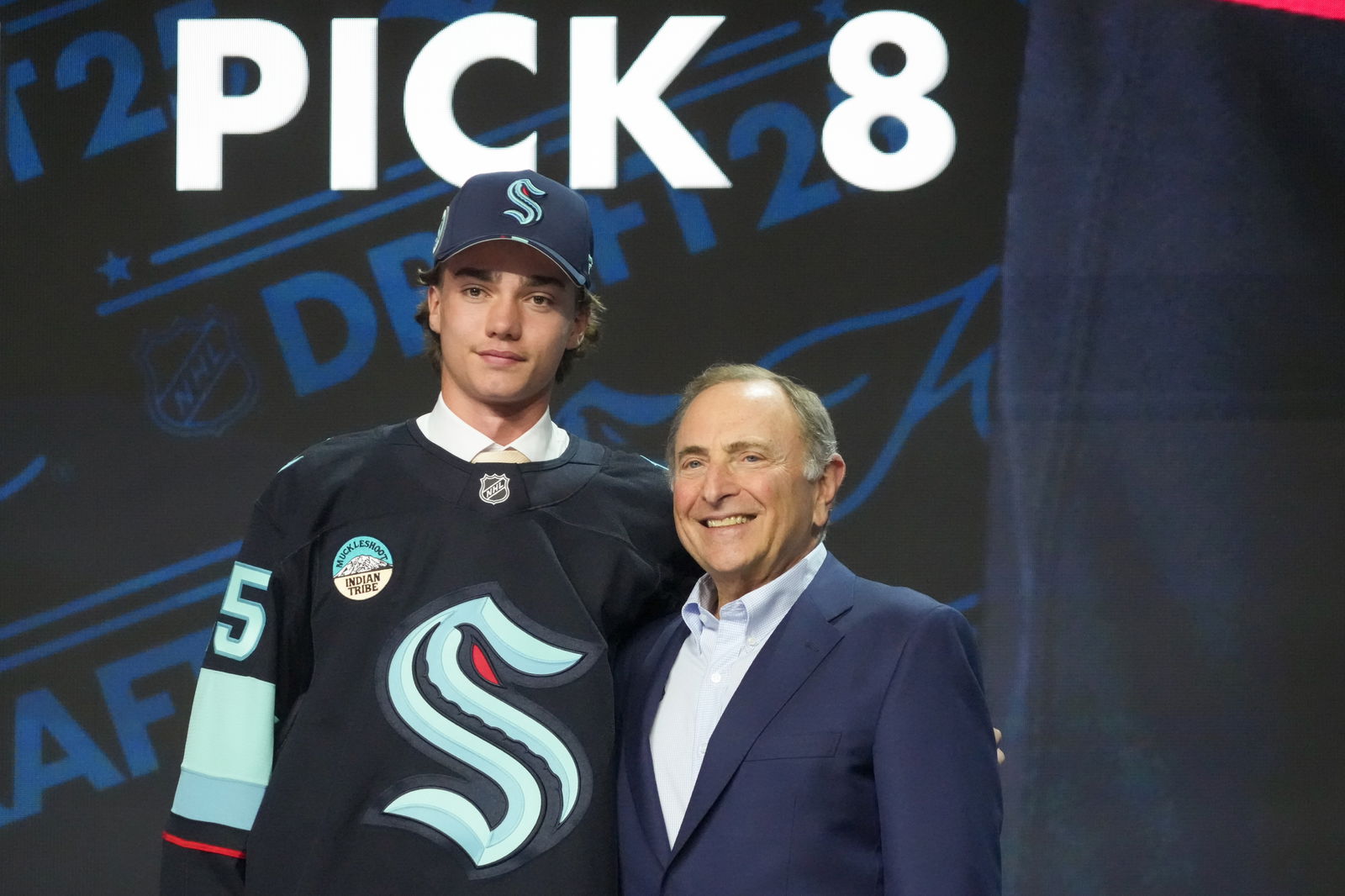
In the second round, the Kraken took advantage of the slight fall for Blake Fiddler, adding the defensive blueliner to their pipeline. Fiddler’s not your typical stay-at-home blueliner. His game offers much more versatility. He’s not an offensive wiz by any means, but he’s more than capable of providing his partner with an outlet or taking the breakout into his own hands as a passer or skater. There are some tools that Fiddler possesses that he could use to attack offensively, but instead, he opts to be the safety blanket who is a reliable option. He has more puck skill than he leads on.
They doubled down on defensive defensemen in round three, taking Will Reynolds out of the QMJHL. His physicality and mobility allow him to shut plays down quickly. He gaps up and closes space as attackers receive passes in the neutral zone, finishes his checks, and doesn’t mess around when the puck is on his stick. He knows what he is, and that’s not an offensive dynamo. He’s a shutdown defender, and he plays a reserved game with the puck, making the simple play.
Seattle went back to the blueline again in round five, taking Russian defender Maxim Agafonov. He’s an interesting player because there are moments that make him look like a very capable two-way defender. He has the mobility and physical play to be a solid play killer, and his flashes of puck carrying ability are intriguing, but the wild inconsistencies and complete lack of motor at times really make him a tough projection. The Kraken drafted him for his potential because of his size, skating, and the fact that he’s right-handed.
The Kraken drafted do-it-all defenseman Karl Annborn with their first of two seventh round picks. Annborn is an interesting prospect because he’s been on the scene for a while now, consistently finding his way onto international teams and consistently playing above his age group on his club team. While he’s always held his head above water and looked solid, he’s never been a player who stood out. Whether he ends up becoming a solid pro in Sweden or a low-end guy in North America, there’s some confidence in Annborn being a long-time pro.
Capping of the Kraken’s draft was Loke Krantz, a big forward from Sweden with a heavy shot and a physical edge. He isn’t the most skilled player, and he certainly doesn’t blow by opposing players, but he shows some good puck protection, and he excels at finding good positioning around the net. He’s a simple player in several ways, but NHL teams love his archetype on the fourth line.
Strengths
The sheer amount of legitimate center depth that the Kraken prospect pool possesses is unreal. They have two higher-end center prospects in Catton and O’Brien, both of whom could be top-six options. Fisker-Molgaard is a two-way force who plays a detailed game. Goyette has been an offensive force everywhere he has been, so there is faith he will figure it out after a trying season in the AHL as a rookie. Ollie Josephson is a transition machine who just gets pucks up ice and makes smart plays with it. Ryan Winterton, Tucker Robertson and Nathan Villeneuve are all at least potential surprise prospects who could wind up in the NHL. Some of these guys will move to the wing, especially with the NHL club already having U23 players Wright and Beniers down the middle, but that’s okay because they’ll need wingers as well, and the added versatility will be nice.
Weaknesses
The Kraken have a very good prospect pool and even their netminders are solid, but none of them have truly stood out as of yet. Nikke Kokko is steady, and he’s been good internationally for Finland, but he’s not really a goalie you can look at to be the guy. Kim Saarinen and Visa Vedenpaa are decent projects, but they have a long way to go to become potential NHL options. The Kraken have been lucky enough to find Joey Daccord at the NHL level for the time being, but they’ll need someone in the crease to step up and fill in behind him eventually and right now, they don’t have a guy that projects.
Hidden Gem: Ollie Josephson, C
Although he lacks the flash of the Kraken’s top prospects, Ollie Josephson is one of the steadiest center prospects around from a defensive point of view. He leverages his high-end mobility and quick thinking to consistently put himself between the puck and the next best option. When he’s defending on the puck or the back check, he’s a hound who gets into the pocket of the puck carrier and pickpockets them. He’s a focused defensive player who always looks for the opportunity to turn the play around and attack up ice. Josephson is heading into his final junior season next year, and you hope to see him get a bit of a boost offensively just to prove that he’s able to keep up. If he can take that step offensively, something he has all of the tools to do, he should transition to the AHL the following year with ease.
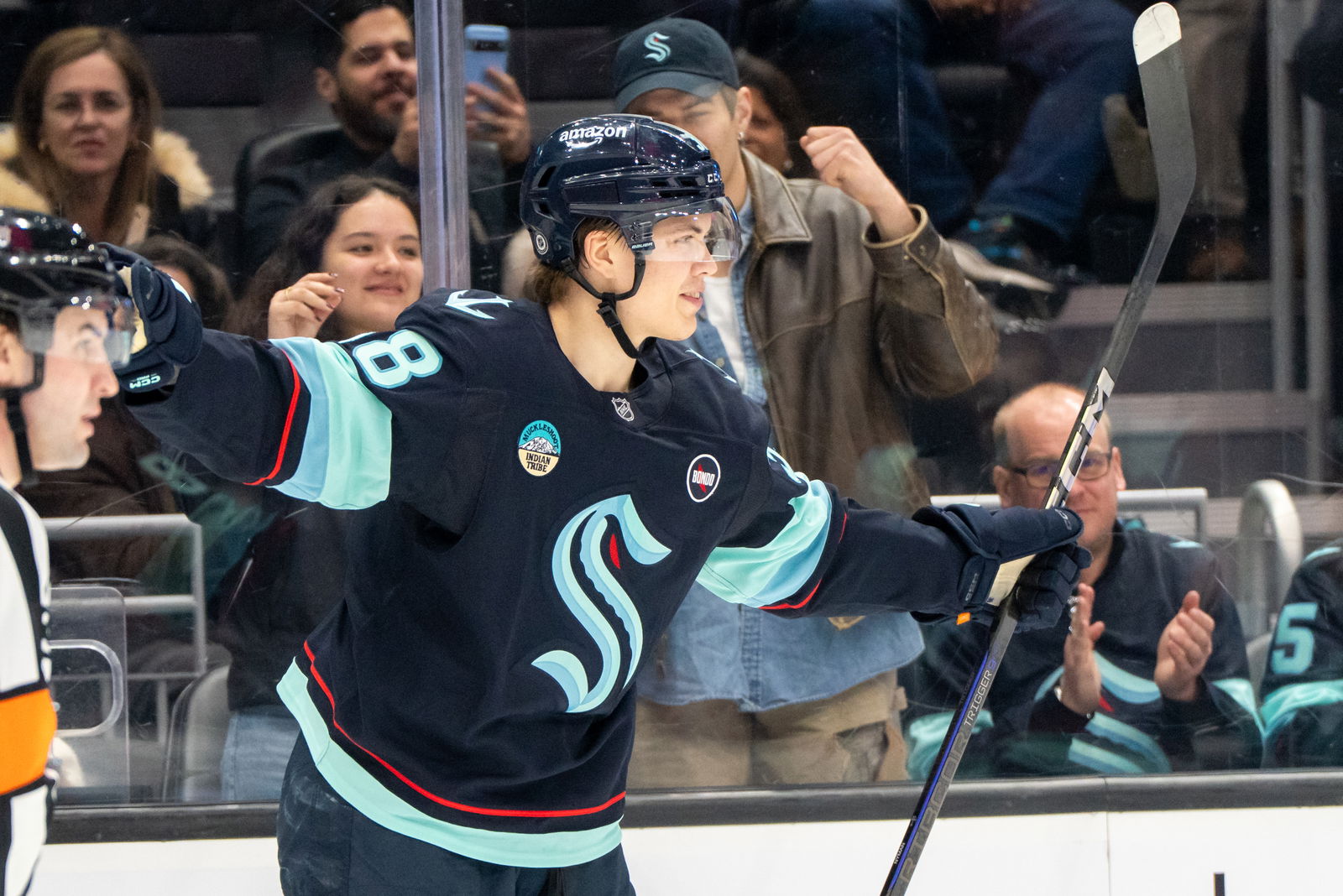
Next Man Up: Jani Nyman, RW
At the tail end of last season, Jani Nyman made the jump to the NHL, and he looked better than expected. He showed himself to be a solid complementary forward, making quick one-touch passes or smart play connecting plays to advance the puck. Nyman is at his best when he’s an off-puck finisher who can find a pocket and get his shot off as soon as he collects the pass. Nyman brought some solid secondary scoring in his dozen-game call-up.
If he can show himself to be capable of that in camp, he should be one of the newest additions to the team to start the season. There aren’t many other prospects that might be ready to jump into the NHL outside of the odd chance that Catton, Rehkopf or Firkus jump up into the NHL, but all of them look like they are at least a year away at this point.
Prospect Depth Chart Notables
LW: Carson Rehkopf, Clarke Caswell, Julius Miettinen, Justin Janicke
C: Berkly Catton, Jake O’Brien, Oscar Fisker Molgaard, Ollie Josephson, David Goyette, Ryan Winterton, Nathan Villenueve, Tucker Robertson
RW: Jagger Firkus, Eduard Sale, Jani Nyman, Andrei Loshko, Loke Krantz
LD: Ryker Evans, Caden Price, Jakub Fibigir, Karl Annborn, Tyson Jugnaugh, Will Reynolds
RD: Blake Fiddler, Lukas Dragicevic, Ty Nelson, Maxim Agafonov, Kaden Hammell, Alexis Bernier, Ville Ottavainen
G: Nikke Kokko, Kim Saarinen, Visa Vedenpaa, Semyon Vyazovoi
For a deeper dive into the prospect pool with player rankings, check out the Yearbook and Future Watch editions of The Hockey News in print.
Read the full article here



